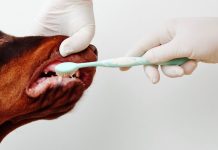If you have a dog, you have no doubt seen her scratch a particular area over and over again. And, upon investigation, you may find that she has bothered her skin raw. It could even be oozy — this is not a good thing at all.
What your buddy is suffering from is a hot spot. Not fatal, certainly, but it can make her very uncomfortable. It’s like having prickly heat in the summer – and you know how annoying that is! Here’s what some experts say on how to spot it and prevent it.
Early Detection is Key
One of our staff members went through this recently: Her Golden was scratching an area near his ear. She didn’t think anything of it because she had just cleaned his ears and everything looked fine. A day goes by. He’s still scratching … but that’s what dogs do, don’t they?
She finally lifted his ear flap and found that he had a huge hot spot that had started to bleed. Of course, she felt terrible and got him in to the vet right away. Besides medication, her Golden had to keep a sock on his back paw to prevent further scratching.
The point of this story is that early detection can prevent a trip to the vet and discomfort on the part of your pet.
Causes
Veterinarian Dr. Henry Cerny says that there are common triggers in and around your home that could be causing hot spots: food, grasses and trees and mites. All of these lead to a moist dermatitis which can develop into a bacterial infection.
How It’s Treated
One of the first things done to our Golden mentioned above was to trim back any fur around the hot spot so the skin will get the air it needs to heal. It’s important to clear up the bacterial infection and that may start with an injection and then be followed up with a topical cream or ointment.
Which Breeds are Prone to Hot Spots?
While any breed can suffer from a hot spot, those with long fur may tend to be more prone than others. If your dog isn’t groomed regularly or those who swim a lot can also be prone as well.
Prevention
Keep your pet groomed and clean, have long fur cut back in the summer, make sure you prevent flea and tick infestations and be vigilant in examining any areas where she may be licking.
Hot spots are a bother, to be sure, but you can keep them to a minimum with our tips. For more information on canine health issues, click the links below!
What You Need To Know About The Dog Flu Breakout




[…] about it. Even if doesn’t appear to be bothering them too badly, you’ll want to address dog skin irritations before they become a more serious […]